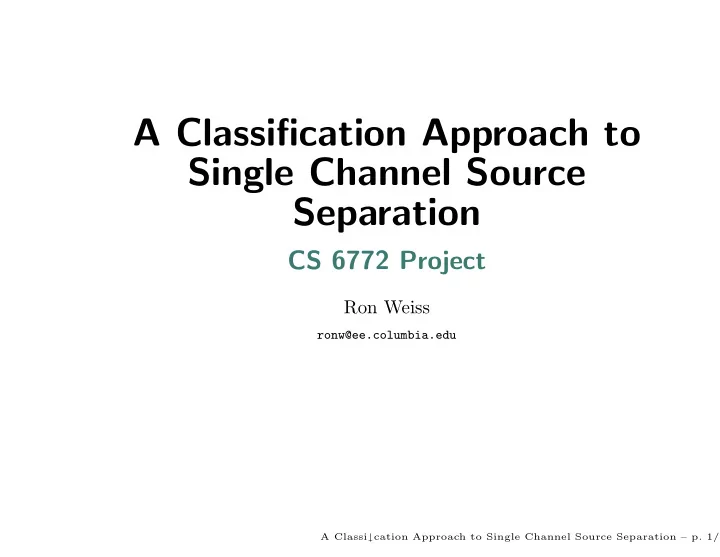

A Classification Approach to Single Channel Source Separation CS 6772 Project Ron Weiss ronw@ee.columbia.edu A Classi↓cation Approach to Single Channel Source Separation – p. 1/8
Single Channel Source Separation Speech Babble noise Mixture (10 dB SNR) 4000 4000 4000 Frequency (Hz) 3000 3000 3000 = + 2000 2000 2000 1000 1000 1000 0 0 0 0 1 2 3 0 1 2 3 0 1 2 3 Time (seconds) Time (seconds) Time (seconds) • Have a monoaural signal composed of multiple sources • e.g. multiple speakers, speech + music, speech + background noise • Want to separate the constituent sources • For noise robust speech recognition, hearing aids A Classi↓cation Approach to Single Channel Source Separation – p. 2/8
What Data Is Reliable? Mixture Mask − regions where speech energy dominates 4000 4000 Frequency (Hz) Frequency (Hz) 3000 3000 2000 2000 1000 1000 0 0 0 1 2 3 0 1 2 3 Time (seconds) Time (seconds) • Only one source is likely to have a significant amount of energy in any given time/frequency cell • If we can decide which cells are dominated by the source of interest (i.e. has local SNR greater than some threshold), can filter out noise dominated cells ( “refiltering”[5]) A Classi↓cation Approach to Single Channel Source Separation – p. 3/8
Binary Masks As Classification [6] • Goal is to classify each spectrogram cell as being reliable (dominated by speech signal) or not. • Separate classifier for each frequency band • Train on speech mixed with a variety of different noise signals (babble noise, white noise, speech shaped noise, etc...) at a variety of different levels (-5 to 10 dB SNR) • Features: raw spectrogram frames • current frame + previous 5 frames ( ∼ 40 ms) of context A Classi↓cation Approach to Single Channel Source Separation – p. 4/8
The Relevance Vector Machine [7] • Bayesian treatment of the SVM • Huge improvement in sparsity over SVM ( ∼ 50 rvs vs. ∼ 450 svs per classifier on this task) • Does more than just discriminate - gives estimate of posterior probability of class membership • So masks are no longer strictly binary. Can use RVM to estimate the probability that each spectrogram cell is reliable. A Classi↓cation Approach to Single Channel Source Separation – p. 5/8
Missing Feature Signal Reconstruction • What if significant part of the signal is missing? • Want to fill in the blanks in spectrogram of mixed signal • Do MMSE reconstruction on missing dimensions: � x m = E [ x m | z ] = µ k,m P ( k | z ) k • Use signal model of spectrogram frames - GMM with diagonal covariance � P ( k | z ) = P ( k ) P ( z | k ) = P ( k ) P ( z d | k ) d • Just marginalize over missing dimensions to do inference � P ( z d | k ) = P ( r d ) N ( z d | µ k,d , σ k,d ) + (1 − P ( r d )) N ( z d | µ k,d , σ k,d ) dz d A Classi↓cation Approach to Single Channel Source Separation – p. 6/8
Example speech + factory2 noise − 0.88695 dB SNR clean speech signal 4000 4000 3000 3000 2000 2000 1000 1000 0 0 0 0.5 1 1.5 0 0.5 1 1.5 RVM mask A priori mask 4000 4000 3000 3000 2000 2000 1000 1000 0 0 0 0.5 1 1.5 0 0.5 1 1.5 Refiltering using RVM mask − 7.7788 dB SNR GMM reconstruction − 8.4013 dB SNR 4000 4000 3000 3000 2000 2000 1000 1000 0 0 0 0.5 1 1.5 0 0.5 1 1.5 A Classi↓cation Approach to Single Channel Source Separation – p. 7/8
References [1] J. Barker, P. Green, and M. Cooke. Linking auditory scene analysis and robust asr by missing data techniques. In WISP , pages 295–307, April 2001. [2] M. P. Cooke, P. Green, L. B. Josifovski, and A. Vizinho. Robust automatic speech recognition with missing and unreliable acoustic data. Speech Communication , 34:267–285, May 2001. [3] B. Raj, M. L. Seltzer, and R. M. Stern. Reconstruction of missing features for robust speech recognition. Speech Communication , 43:275–296, 2004. [4] A. M. Reddy and B. M. Raj. Soft mask estimation for single channel source separation. In SAPA , 2004. [5] S. T. Roweis. Factorial models and refiltering for speech separation and denoising. In Proceedings of EuroSpeech , 2003. [6] M. L. Seltzer, B. Raj, and R. M. Stern. Classifier-based mask estimation for missing feature methods of robust speech recognition. In Proceedings of ICSLP , 2000. [7] M. Tipping. The relevance vector machine. In S. A. Solla, T. K. Leen, and K.-R. Muller, editors, Advances in Neural Information Processing Systems 12 , pages 652–658. MIT Press, 2000. A Classi↓cation Approach to Single Channel Source Separation – p. 8/8
Recommend
More recommend